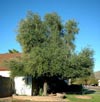North Cyprus Trees
The Kyrenia Range Zone
The zone covers the area of the highest parts of North Cyprus reaching the summit of Servili Tepe (1023 m). Maquis vegetation which grows from the coast up to a level of 300-400 m is predominantly characterized by Pistacio Nut Tree (Pistacia vera), Myrtle (Myrtus communis), Eastern Strawberry Tree (Arbutus andrachne), Calabrian Oak (Quercus infectoria), Kermes Oak (Quercus coccifera), Carob (Ceratonia siliqua) and Olive (Olea europea). Reaching higher, above 500-600 m the Kyrenia Range is dominated by Calabrian Pine (Pinus brutia) and Common Cypress (Cupressus sempervirens).
In Lapta, lining the river-valleys thrive shade-loving species such as Oriental Plane (Platanus orientalis), Blunt-leaved Maple (Acer obtusifolium), Grey Elm (Ulmus canescens) and Storax (Storax officinalis).
The Interior Zone
The Central Plain characterized with low humidity and rainfall is covered with such species as Prickly Jujube (Zizyphus lotus) or the massive weed Prosopis farcta spreading as a low scrub. Along the riverbeds survive salt and drought-loving plant as the Tamarisk (Tamariscus tetragyna). Currently one of the most widespread species, Cyprus Mimosa or Wattle (Acacia cyanophylla) which is drought and fire-resistant was brought here during the British colonial era. The varieties of Eucalyptus, mainly Eucalyptus Camaldulensis and Eucalyptus Gomphocephala along with the Iron Tree (Casuarina angustifolia) stand like isolated monuments in many parts of the Central Plain and here and there form small groves.
Apart from the native forest trees one can find here also a wide variety of aliens that are cultivated here in ornament parks and gardens. They were brought from many lands and include False Acacia (Robinia pseudacacia), Persian Lilac (Melia azedarach), Peruvian Pepper Tree (Schinus molle), White Poplar (Populus alba), Birdlime Tree (Cordia myxa), Rubber Tree (Ficus elastica), Judas Tree (Cercis siliquastrum), Weeping Willow (Salix ssp.) and Jacaranda (Jacaranda mimosifolia).
Much of the fruit of the Mediterranean tree species now represent important commercial food items, among which such fruit as olives, figs, dates or citrus fruit.
Olive and Wilde Olive (Olea europea var. europea and var. silvestris)
The cultivated olive is a broad crowned evergreen which attains 10 to  15 m while the wild olive is a low shrub.
15 m while the wild olive is a low shrub.
The mature cultivated olive has brownish grey bark with narrow ridges and the trunk of a round to square shape. The shoots are ash grey with very small buds and the short stalked leaves grow in opposite pairs, their edges slightly rolled over. The sweet scented white flowers open in April and the fruit which is round or ellipsoid is at first dark green, then turns black, dark brown or purple when ripe around November and have the single seed inside.
The wild olive, a constituent of the maquis, is an indicator of the Mediterranean climate pattern of hot, dry summers and mild winters with low rainfall. We can easily distinguish the wild olive from the cultivated one, as the wild one has its shrubby form (to 2 m), spiny shoot tips and smaller leaves.
Both thrive in a number on the northern slopes of the Kyrenia range and the Karpaz Mountains. During the great fire of 1995 in the Kyrenia Range much of both wild and cultivated olives disappeared.
The olive tree is cultivated not only for the foliage and wood but predominantly for its edible fruit which both immature and ripe is quite acidic and must be properly prepared for human consumption. Oil is extracted from the fruit pulp and used for cooking, canning and an as table oil. Olives for eating are picked either when unripe or ripe. Unripe olives are green and remain so during pickling. Ripe olives are dark bluish when fresh and become blackish during pickling. The seed of the olive is often removed and the cavity stuffed most often with red pepper. The wood of the cultivated olive, being hard and variegated, is widely used in furnishing production.
In addition to the olive, familiar members of the family include ash, lilac, privet, jasmine, forsythia, and the fringe tree.
Page 1 of 3 -- Page 1 - Page 2 - Page 3








